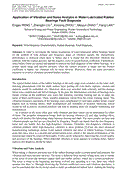p.1977
p.1981
p.1985
p.1990
p.1995
p.2000
p.2004
p.2010
p.2014
Application of Vibration and Noise Analysis in Water-Lubricated Rubber Bearings Fault Diagnosis
Abstract:
In order to investigate the failure mechanism of water-lubricated rubber bearings based on the method of time domain and frequency range of vibration signals, the characteristic performance is analyzed when there is failure and it is found that the abnormal vibration has relations with the contact pressure and the negative curve of speed-friction coefficient. Furthermore, some failure forms are quoted and applied to analyze the fault diagnosis of the rubber bearings. At a certain speed range and specific pressure, when the contact pressure is larger and the friction coefficient is higher, the vibration will be more obvious. Moreover, there are some preventive measures to avoid or eliminate potential hidden troubles.
Info:
Periodical:
Pages:
1995-1999
Citation:
Online since:
September 2011
Authors:
Price:
Permissions:
Сopyright:
© 2011 Trans Tech Publications Ltd. All Rights Reserved

